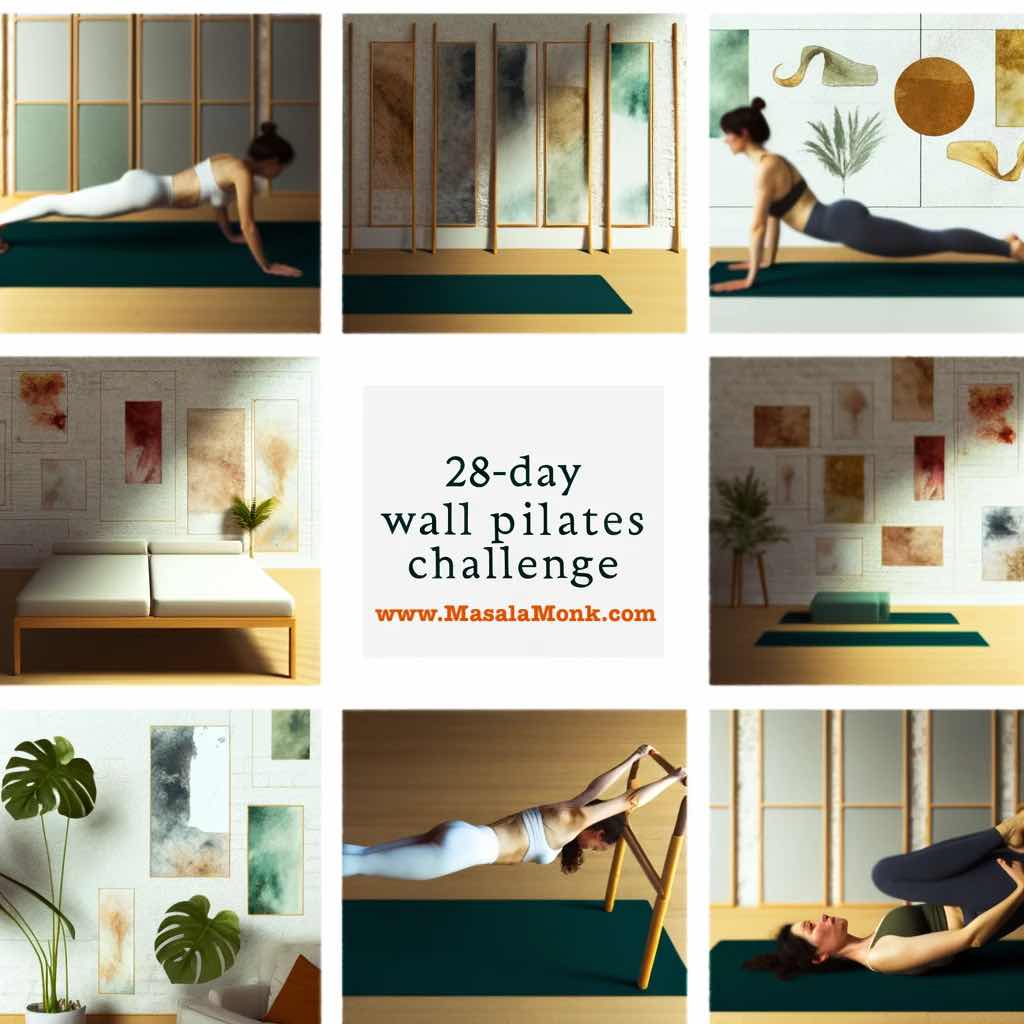
Welcome to Day 2 of Your Pilates Adventure!
Welcome back, Pilates Warriors! Today, we delve deeper into the realms of balance and alignment, forging a stronger connection with our core and enhancing overall stability. As we continue this journey together, remember that every movement brings us closer to our goals of strength, flexibility, and mindfulness. So, let’s roll out our mats, find our center, and embark on Day 2 with renewed vigor and determination!
Introduction:
Day 2 focuses on refining our balance and alignment, crucial elements in mastering the art of Pilates. Through the meticulous guidance of AI optimization, we’ll explore a series of exercises designed to deepen our core connection and improve posture.
Before we start with the day, let us welcome you to the AI-powered 28-Day Free Wall Pilates Challenge! This challenge is designed using modern Artificial intelligence tools. We asked AI to act like a trainer and make a 28-day plan for us. We have put this up as a FREE challenge – do try this and let us know how you feel about it.
28-Day Wall Pilates Challenge
Select the Week to see Day Wise Guides to this AI Designed Challenge.
Warm-Up: Awakening Your Body (5 Minutes)
Cat-Cow Stretch (2 Minutes)
- Execution: Begin on all fours, with your wrists aligned under your shoulders and knees under your hips. Inhale as you arch your back, lifting your chest and tailbone towards the ceiling (Cow Pose). Exhale as you round your spine, tucking your chin to your chest and drawing your belly button towards your spine (Cat Pose). Flow smoothly between these two positions, synchronizing movement with breath.
- Breathing: Inhale deeply as you move into Cow Pose, expanding your chest and belly. Exhale fully as you transition into Cat Pose, engaging your core and drawing your navel towards your spine.
Side Bends (2 Minutes)
- Execution: Sit tall with your legs extended, feet flexed, and arms reaching overhead. Inhale deeply as you lengthen through your spine, then exhale as you bend to one side, reaching your fingertips towards the floor. Inhale to return to center, then exhale to bend to the opposite side. Repeat this flowing movement, maintaining engagement in your core and elongation through your side body.
- Breathing: Inhale deeply to prepare for the movement, exhale as you initiate the side bend, and inhale to return to center. Coordinate your breath with the rhythm of the movement to enhance fluidity and ease.
Neck Rolls (1 Minute)
- Execution: Sit or stand comfortably with your spine tall and shoulders relaxed. Drop your chin towards your chest and begin to circle your head slowly in one direction, feeling the gentle stretch along the back of your neck. After several rotations, reverse the direction of the circles to ensure equal mobilization of the neck muscles.
- Breathing: Breathe deeply and evenly as you perform the neck rolls, allowing your breath to support the movement and encourage relaxation in the neck and shoulders.
Main Session: Balance and Alignment (25 Minutes)
Single Leg Balance (3 Sets, 30-60 Seconds Each Leg)
- Execution: Stand tall with your feet hip-width apart and arms relaxed by your sides. Shift your weight onto one leg and lift the opposite foot slightly off the ground, finding your balance. Engage your core and focus on a point in front of you to help stabilize your gaze. Hold this position for 30 to 60 seconds, then switch to the other leg.
- Breathing: Inhale deeply to center yourself, exhale as you lift your foot off the ground. Maintain steady breaths throughout the balance exercise to promote focus and stability.
Warrior III (3 Sets, 30-60 Seconds Each Leg)
- Execution: Begin in a standing position with your feet hip-width apart. Shift your weight onto one leg and hinge forward from your hips, extending your opposite leg behind you. Reach your arms forward alongside your ears, creating a straight line from your fingertips to your extended heel. Engage your core and focus on lengthening through your spine and reaching through your fingertips. Hold for 30 to 60 seconds, then switch to the other leg.
- Breathing: Inhale deeply as you extend your body forward, exhale to engage your core and maintain balance. Continue to breathe steadily as you hold the pose, finding strength and stability with each breath.
Plank with Leg Lifts (3 Sets, 8-12 Reps Each Leg)
- Execution: Begin in a plank position with your wrists aligned under your shoulders and your body forming a straight line from head to heels. Engage your core and lift one leg off the ground, maintaining stability through your supporting leg and pelvis. Hold for a moment, then lower the leg back to the starting position. Repeat on the other side, alternating legs for 8 to 12 repetitions per side.
- Breathing: Inhale to prepare for the movement, exhale as you lift your leg, and inhale to lower it back down. Coordinate your breath with the movement to enhance control and stability throughout the exercise.
Cooldown: Embracing Stillness (5 Minutes)
Seated Forward Fold (2 Minutes)
- Execution: Sit on the floor with your legs extended in front of you and feet flexed. Inhale deeply to lengthen your spine, then exhale as you hinge forward from your hips, reaching your hands towards your feet. Relax your head, neck, and shoulders, allowing gravity to deepen the stretch along the back of your legs and spine. Hold for 1-2 minutes, breathing deeply and evenly.
- Breathing: Inhale to create space and length in your spine, exhale to deepen the stretch as you fold forward. Breathe deeply into any areas of tension, allowing them to soften and release with each breath.
Spinal Twist (2 Minutes Each Side)
- Execution: Sit tall with your legs extended in front of you. Bend your right knee and cross it over your left leg, placing your right foot flat on the floor outside your left thigh. Inhale to lengthen your spine, then exhale as you twist towards the right, placing your left elbow on the outside of your right knee and your right hand on the floor behind you. Gently deepen the twist with each exhale, feeling the release of tension in your spine. Hold for 1-2 minutes, then switch sides.
- Breathing: Inhale to lengthen your spine and create space between each vertebra, exhale to deepen the twist as you rotate towards the right. Continue to breathe deeply and evenly, allowing your breath to facilitate the release of tension in your spine and muscles.
Reflection and Gratitude
Congratulations on completing Day 2 of the 28-Day Wall Pilates Challenge! Take a moment to reflect on the progress you've made and express gratitude for your body's strength and resilience. As you continue on this journey, remember to listen to your body, honor its needs, and celebrate each step forward. I'll see you tomorrow for Day 3, where we'll explore new avenues of movement and deepen our connection with mind, body, and spirit.
Join Our 28-Day Wall Pilates Challenge
Are you ready to embark on a transformative journey to strengthen your body, mind, and spirit through Pilates? Welcome to our 28-day Wall Pilates Challenge, designed to ignite your passion for Pilates and unlock your full potential!
Overview:
- Duration: 28 days
- Focus: Core strength, flexibility, balance, endurance, and overall well-being
- Structure: Each week focuses on specific themes and goals, with daily workouts to guide you through the challenge.
Week 1: Core Foundations
Day 1: Core Foundations - Ignite Your Pilates Journey
Start your journey with foundational Pilates exercises to build a strong core and establish proper alignment.
Day 2: Balance and Alignment - Strengthen Your Core Connection
Focus on improving balance and alignment to enhance core stability and connection.
Day 3: Flexibility Flow - Unlock Your Body's Potential
Enhance flexibility and fluidity in movements to unlock your body's full potential.
Day 4: Power and Stability - Strengthen Your Pilates Foundation
Build power and stability for a solid Pilates foundation with challenging exercises.
Day 5: Endurance Elevation - Embrace the Power Within
Increase endurance and stamina through dynamic Pilates workouts.
Day 6: Harmony in Motion - Cultivating Balance and Coordination
Cultivate balance and coordination for graceful and harmonious movement.
Day 7: Rest and Rejuvenate - Nourishing Your Pilates Journey
Take a day to rest and rejuvenate your body and mind, allowing for optimal recovery.
Week 2: Mindful Movement
Day 8: Mindful Movement - Deepening Your Pilates Practice
Deepen your Pilates practice through mindfulness and focused movement techniques.
Day 9: Strengthen and Lengthen - Unleash Your Inner Warrior
Strengthen muscles while promoting lengthening and flexibility for a balanced body.
Day 10: Core Stability and Balance - Finding Your Center of Strength
Enhance core stability and find your center of strength through targeted exercises.
Day 11: Mobility and Flexibility - Embrace Fluid Movement
Embrace fluid movement by improving mobility and flexibility in your Pilates practice.
Day 12: Alignment and Posture - Discover Your Perfect Balance
Focus on proper alignment and posture to achieve balance and prevent injuries.
Day 13: Strength and Endurance - Building Resilience Within
Build strength and endurance to overcome challenges and build resilience.
Day 14: Rest and Recovery - Nourish Your Body and Mind
Take a well-deserved day of rest and recovery to rejuvenate your body and mind.
Week 3: Full Body Flow
Day 15: Balance and Coordination - Find Your Center of Gravity
Explore balance and coordination exercises to find your center of gravity and enhance stability.
Day 16: Flexibility and Mobility - Embrace Fluidity in Motion
Improve flexibility and mobility to move with grace and ease through dynamic movements.
Day 17: Core Strength and Stability - Ignite Your Power Center
Ignite your power center with core-strengthening exercises for stability and strength.
Day 18: Upper Body Strength and Toning - Sculpt Your Pilates Powerhouse
Sculpt and tone your upper body muscles for improved strength and definition.
Day 19: Balance and Coordination - Find Your Center of Gravity
Continue refining balance and coordination skills to enhance your Pilates practice.
Day 20: Flexibility and Mobility - Unlock Your Body's Potential
Unlock your body's full potential by increasing flexibility and mobility for greater range of motion.
Day 21: Rest and Reflect - Nourish Your Body and Mind
Reflect on your progress and take time to nourish your body and mind with rest and relaxation.
Week 4: Lower Body Strength
Day 22: Lower Body Strength - Building Foundations
Focus on building a strong foundation for lower body strength through targeted exercises.
Day 23: Core Power - Ignite Your Center
Ignite your core power with exercises designed to strengthen and stabilize your center.
Day 24: Full Body Flow - Harmony in Motion
Experience the harmony of full-body movement with flowing Pilates sequences.
Day 25: Lower Body Burn - Sculpt and Strengthen
Sculpt and strengthen your lower body muscles with targeted exercises to feel the burn.
Day 26: Core Strength - Ignite Your Powerhouse
Ignite your powerhouse with core-strengthening workouts for a strong and stable center.
Day 27: Flexibility and Mobility - Embrace Fluidity
Embrace fluidity in movement by enhancing flexibility and mobility in every workout.
Day 28: Final Challenge and Celebration - Embrace Your Triumph
Celebrate your achievements and embrace the final challenge as you complete the 28-Day Wall Pilates Challenge.
We invite you to join us on this exciting journey and share your experiences and feedback. Together, let's fine-tune and improve this challenge to help others achieve their fitness goals. Are you ready to embrace the 28 Days Wall Pilates Challenge? Let's get started!
Don't forget to check out our interactive navigation app above to easily access each day's workout details. Let the challenge begin!
Best regards,











